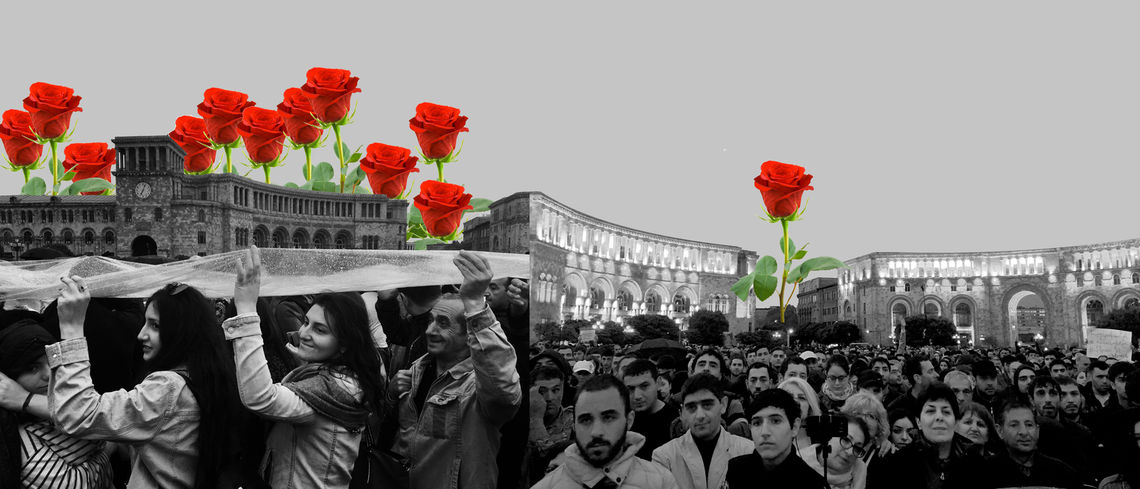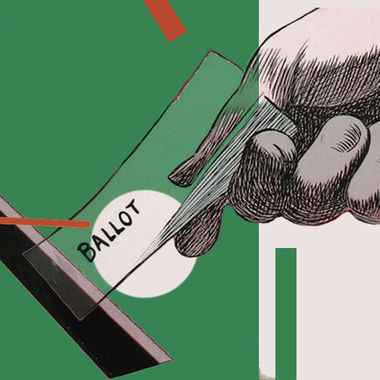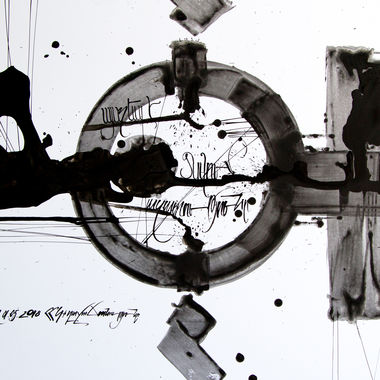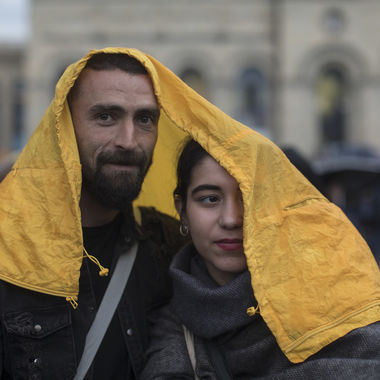
Following Armenia’s recent “Love and Tolerance” revolution (Velvet Revolution), many began drawing parallels with the Rose Revolution, which took place in neighboring Georgia 15 years earlier. Examples of Georgian President Mikheil Saakashvili’s experience were proffered. A number of articles highlighting the similarities between the two revolutions were published, highlighting lessons that could be drawn from the Rose Revolution and the mistakes to avoid.
During an interview, Armenia’s Deputy Prime Minister, Tigran Avinyan stated, “The fundamental difference between the events in Georgia and Armenia is that for us, there will be no vendetta. The negative aspects that I felt were present in the Georgian government of that time is completely absent in ours.” Avinyan’s statement was made on May 16, a week after Nikol Pashinyan had been elected as the country’s new Prime Minister.
The differences and similarities between both revolutions can be discussed at length including, who the true leaders of the revolution were, what the role of university students in both countries was, how the revolutions were financed, and how those in power came to rule. The following article will explore points that have not been examined closely or have been entirely omitted by the Armenian press.
Teamwork
Unlike the revolution which took place in Armenia, where there was one dominant political force, in Georgia there was a wide range of political powers.
On March 31 of this year, the “My Step” campaign, conceived by the Civil Contract Party, kicked off in Gyumri’s Vardanants Square. Leader of the Civil Contract, Nikol Pashinyan, with a small group of people, embarked on a two-week trek through the country to rally citizens to join them in protesting the upcoming election of Serzh Sargsyan as Armenia’s prime minister.
In 2017, the Civil Contract Party formed the Yelq Alliance with the Republic Party and the Bright Armenia Party to participate in the parliamentary elections. Securing 7.77 percent of the vote, the Yelq Alliance made it to parliament and announced that there had been abuses of administrative and financial resources and the “will” of the elections had been subjected to these abuses.
Two of the political forces comprising the Yelq Alliance, who had been able to secure seats in the National Assembly following the 2017 parliamentary elections, refused to take part in the “My Step” movement. They saw the materialization of their “struggle” through other means. The leader of the Bright Armenia Party, Edmon Marukyan published an article in Aravot on April 4, stating: “We’ve had numerous opportunities to reiterate that we do not believe the argument being circulated by our fellow alliance members that the people can hinder Serzh Sargsyan from becoming Prime Minister.”
Indeed, Nikol Pashinyan and his political party started the “My Step” movement on their own. This coincided with the “Reject Serzh” initiative that was also attempting to prevent Serzh Sargsyan’s third term in office from becoming a reality.
In Georgia, things were much different. Mikheil Saakashvili, who was elected president after receiving an unprecedented 96.27 percent of the vote, battled alongside other political forces. The most prominent was the Burjanadze-Democratic party, formed by the former Speaker of Parliament Zurab Zhvania, Nino Burjanadze, and the Union of Georgian Traditionalists, led by Akaki Asatiani. In addition, a youth resistance movement was rapidly spreading among university student activists called Kmara (Georgian for Enough!), which will be discussed later.
Armenia’s revolution was for the most part taking place based on the principle of self-organization, however, the “My Step” and “Reject Serzh” initiatives were the driving force and the ones that later came to power. In Georgia the political parties were manifold. Each had a different point of view, especially concerning their vision of the revolution and political reform; because of this, perhaps, the political forces formed during the revolutionary period did not last long. Burjanadze, who was Speaker of Parliament before the revolution and later served as acting president after Eduard Shevardnadze resigned in 2003, and again when Saakashveli resigned in 2007, soon after became part of the opposition. This was preceded by a series of critical events; to begin with, the Saakashvili-led United National Movement Party list for parliamentary elections did not include Burjanadze’s favorites. This ultimately resulted in Burjanadze refusing to run under the National Movement’s proportional party-list. Later, in 2008, Burjanadze formed the Democratic Movement-United Georgia opposition party which, during the spring protests of 2009, demanded Mikheil Saakashvili’s resignation. And, in 2005, Zurab Zhvania “died” under mysterious circumstances.
From Government to Government
related
Pashinyan’s War
By Nerses Kopalyan
Nerses Kopalyan writes that Prime Minister Nikol Pashinyan’s declaration of war against the entrenched powers of the previous system is not simply a singular attack against corruption, but rather a broad multi-pronged strategy that envisions an ideational restructuring of Armenia’s political culture.
Armenia’s New Electoral Code: Open vs. Closed Party Lists and Other Considerations
By Harout Manougian
Prime Minister Nikol Pashinyan promised to call snap elections as soon as the country’s Electoral Code could be amended to allow for a fair race. Currently there are two bodies forming recommendations. Harout Manougian looks at the intricacies of the Electoral Code and in this first article writes about open vs. closed party lists.
The second difference between the revolutions was the experience in state governance. Unlike in Armenia, Georgia’s revolutionary leaders were former state officials, as well as principal members of the then ruling Union of Citizens of Georgia Party (also known as the Georgian Citizens’ Union Party ). In 1995, the symbol of the Rose Revolution, Mikheil Saakashvili, had been invited by Zhvania personally to become a party member.
That same year, Saakashvili became a parliament member and from 1995-1998, served as Chair of the Parliamentary Committee for Constitutional and Legal Affairs. From 1998-1999, he was head of the Union of Citizens of Georgia faction. He was elected to a second term in the parliamentary elections under the same party in 1999. On Oct. 12, 2000, Saakashvili was appointed Minister of Justice and served in that position until Sept. 19 of the next year.
His resignation from his position, as he later claimed, was conditioned by the absence of Shevardnadze’s support in the battle against corruption.
In 1995, Nino Burjanadze, along with Saakashvili, was elected as parliament member on the proportional list of the Union of Georgian Citizens. Until 1998, she served as the First Deputy Chair of the Parliamentary Committee for Constitutional and Legal Affairs; and when Saakashvili became the leader of the party faction, she became chair of the committee. In 1999, Burjanadze, like Saakashvili, was elected for a second term in parliament through the ruling political party’s electoral list. In 2001, she became the Speaker of the Georgian Parliament.
Zurab Zhvania, however, was perhaps the most experienced. From 1995-2001, he served as Speaker of Georgia’s parliament, was the Secretary General of the Union of Georgian Citizens and after the revolution served as State Minister and then Prime Minister.
The revolutionaries in Armenia had no prior experience in governance, but when it came to street protests, they had a wealth of experience that their Georgian counterparts did not.This is apparent when one examines the biographies of Nikol Pashinyan and many of his teammates.
Of course, there are varying opinions. Some say that it is important to have prior experience in state governance in order to properly assume political responsibility later. Others claim that prior experience gained during the previous regimes can be disruptive. Nika Rurua, Georgia’s previous Culture Minister and parliament member of the sixth and seventh convocation of parliament, argued that prior political experience was completely unnecessary for revolutionary leaders.
The Students and the Revolution
University students have almost always played a pivotal role in realizing revolutions and not only. We can recall the civil unrest in France in 1968 when university students were yelling, “Sex and solidarity!” It is also important to remember Serbia, as it is directly tied to the Rose Revolution’s actively involved student-youth movement Kmara.
This student-youth movement was created in 2001. A group of students at Tbilisi State University began complaining of corruption within the university. In 2003, their campaign was officially named Kmara, and they began their fight against President Eduard Shevardnadze. The movement thoroughly utilized the principles and experiences of the Serbian political organization Otpor (Resistance!), even co-opting their flag. After the Rose Revolution, Kmara continued its revolutionary activities outside of the country, participating in Ukraine’s Orange Revolution and was also active in Belarus. On August 24, 2005, when police in Belarus arrested Vladimir Kobets, the leader of Zubr, a Belarusian youth resistance movement, two Kmara members, Giorgi Kandelaki and Luka Tsuladze, were also detained. Kobets was released shortly after the arrest, but the Belarusian government kept the two Georgians imprisoned for 15 days on account of “hooliganism.” The Georgian Foreign Ministry, President Saakashvili, and Amnesty International demanded their freedom, and on Sept. 1, they were released.
During the Georgian revolution, the youth movement was one of the most active opposition forces against Shevardnadze. People remember Kmara painting anti-government graffiti in the streets. After the revolution, most of the movement’s members, as well as its founders, became part of the government such as member of parliament and Secretary of the National Security Council Giga Bokeria, and the former mayor of Tbilisi, Giorgi “Gigi” Ugulava. It was Bokeria himself, who after visiting Serbia, brought back with him the revolutionary experience and contacts of the resistance movement Otpor. The same fundamental principles and demands were used in Georgia: non-centralized leadership, frequent protests against the political rule of Shevernadze, political street art, and so on. Kmara, unlike Otpor, eventually became absorbed into the government. Even after overthrowing President Slobodan Milošević of Serbia and Montenegro, and helping instate a new government, Otpor continued working as an opposition force.[1]
University students in Armenia also played an important role in governmental change. The student resistance movement began earlier in 2017 as a response to parliament passing a bill that ended military draft deferment for university students; they, the students, were demanding deferment. “For the Development of Science” was the name of the student protest movement yet they were unsuccessful in securing military deferment. Later, a student-organized initiative called YSU Restart was formed, with a large portion of the members hailing from “For the Development of Science.” They demanded reforms within institutions of higher education. They also declared that the ruling Republican Party and Serzh Sargsyan should be banished, blaming them for the dysfunctional condition of universities and in general, Armenia itself.
This youth movement from the beginning was mistrustful of the Republican Party. This stemmed partly from the ineffectiveness of their negotiations with the government concerning military service deferment. And during the revolution, the youth resistance movement was the one that generated popular slogans such as, “Serzh-less Armenia,” “Free and Independent Students,” and so on. They declared that they felt imprisoned and persecuted for their beliefs, not only in university settings, but in the entire country. These feelings were amplified due to the fact that all of the higher education institutions were politicized.
After the revolution, this student initiative continued its’ civic struggle, focusing on education and civic-based activism.
Financing
Visual Art and the Revolution
Visual artist Ruben Malayan’s poster art that he created during the Velvet Revolution in Armenia is a fusion of his passion for calligraphy and the momentous events sweeping across the country.
Portraits From Republic Square
By Eric Grigorian
Photojournalist Eric Grigorian's series of portraits from Republic Square where thousands gathered in protest as Yerevan enters the seventh day of mass rallies, protests and innumerable acts of civil disobedience.
Over the past decades, it has become quite “standard” to credit the organization and execution of revolutions to transnational powers abroad, in particular to George Soros. The events that took place in both Armenia and Georgia were not exempt from similar “accusations.”
The suspicions in Armenia were dispelled when Prime Minister Nikol Pashinyan published the financial resources spent by his movement during the revolution, down to the last penny. In Georgia’s case however, even to this day, there is speculation concerning Western funding, which the revolutionaries still repudiate. Western-backed financing of the Georgian revolution is a subject matter that is denied both by the potential financial investors, and those who theoretically received it. In spite of this, the post-revolutionary financial period in Georgia is even more noteworthy.
The “inheritance” that Shevardnadze left behind was certainly not propitious. The new government was forced to wage war against criminal groups while attempting to resolve fundamental economic and security issues. Naturally, all of this required financing.
In 2005, the founder of Open Society Foundation, billionaire George Soros, visited Georgia for three days. He had various meetings with the country’s political elite and, when it came time to summarize his experience, announced that, “Much has changed in Georgia after the Rose Revolution.” Soros paid special attention to the government’s anti-corruption campaign, as well as the reforms taking place within the Ministry of Internal Affairs. His interest in these subject matters, however, was rooted in a time before the revolution. During Shevardnadze’s presidency, George Soros had engaged in anti-corruption campaigns with the authorities in power alongside the Minister of Justice at the time, Mikheil Saakashvili, and Speaker of Parliament, Zurab Zhvania. In 2007, during an interview with Prague’s RFE/RL broadcasting center, Soros said, “Shevardnadze could not deliver on his promises or his commitments because the main source of corruption in Georgia was the Ministry of the Interior -- the police, and he was completely dependent on the police.”
What’s remarkable is that Saakashvili expressed a similar idea when he left office claiming that he did not receive support from Shevardnadze in his fight against corruption. Later, Soros’s Open Society Foundation provided funds to Georgia for anti-corruption initiatives, reforms, and increasing wages for state workers. This story might have ended there had it not been for the Russian Forbe’s interview with Georgia’s former prime minister, billionaire Bidzina Ivanishvili. In the interview, Ivanishvili revealed that he had provided the majority of funding through Soros’s foundation: “We used the Soros Foundation; but Soros’ investment, if it even existed, was insignificant. All the money that went to increasing wages was mine. For more than two and a half years, officials received a higher salary thanks to this fund. At the same time, no one knew or showed interest in knowing where that money was coming from.” Ivanishvili stopped short of mentioning a specific figure. He also claimed to have helped the army and police force.
In Armenia, transcripts of the revolution’s financial records were made public. These reports clearly showed money that every individual had contributed. Furthermore, any doubts and suspicions concerning foreign forces or Western involvement soon vanished when it became apparent that the Republic of Armenia was not changing its foreign policy vector. Russia remains the Republic of Armenia’s strategic ally. Previously, the very force that had called for a parliamentary discussion about Armenia’s possible withdrawal from the Eurasian Economic Union, the same force that came to power after the revolution, declared time and again that there will be “no geopolitical reverses” after they assume power. As Prime Minister, Nikol Pashinyan’s first order of business took him to Sochi, Russia, where he attended the session of the Supreme Eurasian Economic Council. It is interesting to note that Mikheil Saakashvili’s first official visit once in power was also to Russia.
Elections
“Governments are instituted among Men, deriving their just Powers from the Consent of the Governed,” wrote Thomas Jefferson. On Dec. 10, 1948, the UN General Assembly approved the Universal Declaration of Human Rights, of which Article 21 states, “Everyone has the right to take part in the government of his country, directly or through freely chosen representatives...The will of the people shall be the basis of the authority of government.”
Elections are the fundamental mechanism of democracy; ultimately, those who are elected to state and political positions are accountable to those who voted for them. According to law, elections are required to be held in free and equal conditions. This means that candidates running for office must be of equal position, and voters must be free to make their own decisions. In many countries, including Armenia and Georgia, there were many questions concerning elections, which still remain. In both of these post-Soviet countries, elections were almost always followed by demonstrations protesting inequality and an absence of freedom. In Armenia, the most tragic example of such demonstrations happened on March 1, 2008. Ten people were killed and the criminal case is still open to this day. This is yet another essential difference between the Armenian and Georgian revolutions.
The revolution in Armenia did not take place in the form of demonstrations following an election, but rather because Serzh Sargsyan attempted to seize power and prolong his rule. Using the constitutional amendments, he increased the powers of the prime minister and reduced those of the president. According to the previous Constitution of the Republic of Armenia that set term limits, he would not have been able to seek a third term as president. During the process of amending the Constitution - which fundamentally included switching the country from a presidential to a parliamentary system - Serzh Sargsyan announced that he would not be seeking a third term in office.
On the other hand, the revolution in Georgia was the post-election demonstrations. Following the elections, a three week struggle in the streets resulted in the resignation of President Eduard Shevardnadze. He announced his resignation on Nov. 23. Then, on Jan. 4, for the first time in Georgian history, snap presidential elections were held. Saakashvili received 96.27 percent of the vote (about 1,890,000 votes).
On March 28, 2003, 84 days after the presidential elections, and 42 days after Eduard Shevardnadze’s resignation, parliamentary elections were held in Georgia. The elections were implemented without electoral reform, which deeply concerned the Council of Europe. The Council had concerns regarding the formation of the Central Electoral Commission and the precinct election commissions and also called for lowering the electoral threshold from seven percent to four or five percent. It is significant to note that the Supreme Court of Georgia annulled only the proportional part of the vote, but the results of the majoritarian elections were left unchanged. This meant that, in the 235-member parliament, 85 majoritarian deputies were elected in 2003, and on March 28, 2004, 150 deputies were elected to the proportional component of the parliament. From the results of the proportional election, two political parties gained standing in parliament: the National Movement-Democrats with 135 mandates, and the Right Opposition with 15 mandates.
In Armenia, almost four months have passed since the change in government, but it is still unclear when snap parliamentary elections will be held or how the current parliament will be dissolved. The current ruling team, along with the opposition and civil society, is still working on reforming the Electoral Code. The government has suggested lowering the threshold needed for political parties to enter parliament to four percent from the current five percent; and six percent for political alliances from the current seven percent. Certain political forces are talking of lowering the threshold even more.
The differences between the revolutions in Georgia and Armenia do not end here. For example, in Georgia, there is a region called Ajaria, where the revolution took a little bit longer to reach than all of Georgia (not counting the territories of South Ossetia and Abkhazia). Furthermore, everything in Georgia was organized by the leaders, whereas the principle of self-organization was present from the beginning in Armenia, and so on. At the same time, there were also similarities: peaceful protests and civil disobedience, one throwing roses, and the other, love and tolerance.







